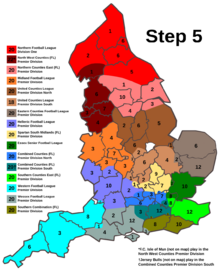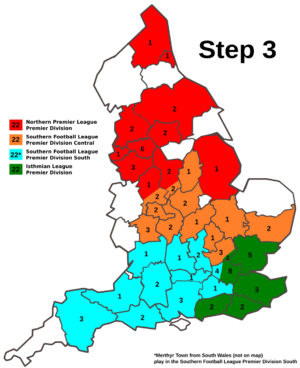English football league system facts for kids
| Country | England |
|---|---|
| Sport | Association football |
| Promotion and relegation | Yes |
| National system | |
| Federation | Football Association |
| Confederation | UEFA |
| Top division | |
| Second division | |
| Cup competition | |
| Association football in England | |
The English football league system is like a giant pyramid for men's football clubs in England. It's also called the football pyramid. A few teams from Wales, Guernsey, Jersey, and the Isle of Man also play in it.
This system has many connected leagues. Teams can move up (get promotion) or down (face relegation) between different levels. This means even a small local club could, in theory, one day reach the very top, the Premier League!
The top level is the Premier League. Below that are levels 2-4, run by the English Football League. Then, from levels 5-10, it's the National League System, managed by the FA. Below level 10, local leagues are run by county FAs.
There are thousands of teams in this system. The exact number changes each year.
There's also a separate pyramid for women's football in England. It has ten levels.
Contents
History of English Football Leagues
Football leagues have a long history in England. The world's first football league was created in 1888. It was simply called The Football League.
William McGregor, a director at Aston Villa, helped start it. Twelve teams were the first members. Six were from Lancashire, including Blackburn Rovers and Everton. Six were from the Midlands, like Aston Villa and Wolverhampton Wanderers. These clubs were the first to play professional football.
In 2014, there were ideas to add a new division. This division might have included "B" teams from bigger clubs. However, these plans were later stopped.
How the Pyramid Works
The English football league system is a pyramid of leagues. It's all connected by promotion and relegation. This means:
- The best teams in a league can move up to a higher league.
- The teams that finish at the bottom of their league can move down a level.
To get promoted, a club needs to play well. They also need to meet certain rules. These rules are about things like their stadium and money.
The top five levels of the pyramid each have one league. These leagues cover the whole country. Below that, there are more leagues. Each covers a smaller area. Many leagues also have more than one division. In some busy areas, there are leagues more than twenty levels below the Premier League!
Some local leagues are not officially part of the pyramid. But clubs from these leagues can apply to join the main system if they are good enough.
Pyramid Levels Explained
The very top of the pyramid is the Premier League. This is Level 1 and has 20 clubs. It's often called the "top flight."
Below the Premier League is the English Football League (EFL). It has three divisions, each with 24 clubs:
- The Championship (Level 2)
- League One (Level 3)
- League Two (Level 4)
All 20 clubs in the Premier League and 72 clubs in the EFL are full-time professional teams. Before 1992, the Football League included all 92 of these clubs. Clubs outside these top four divisions are called "non-League clubs." Levels 1 to 4 are known as "League Football."
The top part of non-League football is the National League.
- It has one national division (the National League) at Level 5 (Step 1). This league has 24 clubs. It's the lowest level with just one national league. Most clubs here are professional.
- Below that, at Level 6 (Step 2), there are two divisions: National League North and National League South. Each has 24 clubs. Some of these clubs are professional, others are semi-professional.
- As you go further down the pyramid, most clubs become amateur.
Below the National League, at Levels 7 and 8 (Steps 3 and 4), there are three regional leagues:
- Northern Premier League (for northern England)
- Southern Football League (for the Midlands, south, and southwest England)
- Isthmian League (for southeastern England and the Channel Islands)
These leagues have different divisions. Most divisions usually have 22 teams.
Level 9 (Step 5) has 16 smaller, local leagues. Each of these leagues has even more leagues below them. These lower leagues cover smaller and smaller areas.
The six levels right below League Two are called the National League System. The FA oversees them.
The English football league system does not include amateur "Sunday league football." These leagues are separate. However, some Sunday league teams have joined the pyramid to try and move up.
How Teams Move Up and Down (Top 8 Levels)
Here's how promotion and relegation generally work for the top levels:
- Premier League (Level 1, 20 teams): The bottom three teams move down.
- EFL Championship (Level 2, 24 teams): The top two teams move up automatically. The next four teams play in a mini-tournament (play-offs). The winner gets the third promotion spot. The bottom three teams move down.
- EFL League One (Level 3, 24 teams): Similar to the Championship, top two go up automatically. The next four play-off for the third spot. The bottom four teams move down.
- EFL League Two (Level 4, 24 teams): The top three teams move up automatically. The next four play-off for the fourth spot. The bottom two teams move down.
- National League (Level 5, 24 teams): The champions move up automatically. The next six teams play-off for the second spot. The bottom four teams move down to either the National League North or South.
- National League North and South (Level 6, 24 teams each): The champions of each division move up automatically. The next six teams in each division play-off for the second promotion spot. The bottom four teams in each division move down to a Level 7 league.
- Level 7 Leagues (Northern Premier League Premier Division, Southern League Premier Central, Southern League Premier South, Isthmian League Premier Division - 22 teams each): The champions of each division move up automatically. The next four teams in each division play-off for another promotion spot. The bottom four teams in each division move down to a Level 8 division.
- Level 8 Leagues (Various divisions like Northern Premier League Division One East, Southern League Division One Central, etc. - 22 teams each): The champions of each division move up automatically. The next four teams in each division play-off for another promotion spot. The bottom four teams in each division move down to a Level 9 division.
Teams are sometimes moved between parallel leagues (like North and South) to keep the numbers even.
Cup Competitions
Being in a certain league level also means teams can play in different cup competitions. These are single-elimination tournaments.
- FA Cup: Teams from Levels 1 to 10 can enter. Top-level teams join later.
- EFL Cup: Teams from Levels 1 to 4.
- EFL Trophy: Teams from Levels 3 to 4. Some Under-21 teams from top clubs also play.
- FA Trophy: Teams from Levels 5 to 8.
- FA Vase: Teams from Levels 9 to 10.
- FA Inter-League Cup: Teams from Level 11.
- National League Cup: Teams from Level 5. Some Under-21 teams from top clubs also play.
For the FA Cup, how many teams from Level 10 get in depends on their league position. For example, in the 2017–18 FA Cup, 77 teams from Level 10 played.
Below Level 11, the cups become regional. Further down, they are often based on counties. Some "Senior Cups" are local competitions between professional clubs.
The System in Detail
The Premier League runs Level 1. The winner is the champion of England. The English Football League runs Levels 2 to 4. These four divisions together are "league football."
Leagues below Level 4 are "non-League football." This means they are outside the EFL. Levels 5 to 10 are part of the National League System (NLS). The FA directly manages them. Level 5 is "step 1," Level 6 is "step 2," and so on. Until 2020, Level 11 divisions were called "step 7." Now they are "Regional Feeder Leagues."
After the 2023–24 season, some changes were made. More clubs were promoted from certain levels. This helped to make the number of teams in each division more consistent.
|
Level |
Total clubs (approx.) |
League(s) / division(s) |
|||||||||||||||||||||||||||||||
|---|---|---|---|---|---|---|---|---|---|---|---|---|---|---|---|---|---|---|---|---|---|---|---|---|---|---|---|---|---|---|---|---|---|
|
1 |
20 |
Premier League |
|||||||||||||||||||||||||||||||
|
2 |
24 |
EFL Championship |
|||||||||||||||||||||||||||||||
|
3 |
24 |
EFL League One |
|||||||||||||||||||||||||||||||
|
4 |
24 |
EFL League Two |
|||||||||||||||||||||||||||||||
|
5 (Step 1) |
24 |
National League |
|||||||||||||||||||||||||||||||
|
6 (Step 2) |
48 |
National League North |
National League South |
||||||||||||||||||||||||||||||
|
7 (Step 3) |
88 |
Northern Premier League Premier Division |
Southern League Premier Division Central |
Southern League Premier Division South |
Isthmian League Premier Division |
||||||||||||||||||||||||||||
|
8 (Step 4) |
175 |
Northern Premier League Division One East |
Northern Premier League Division One West |
Northern Premier League Division One Midlands |
Southern League Division One Central |
Southern League Division One South |
Isthmian League Division One South Central |
Isthmian League Division One North |
Isthmian League Division One South East |
||||||||||||||||||||||||
|
9 (Step 5) |
319 |
Northern League Division One |
Northern Counties East League Premier Division |
North West Counties League Premier Division |
Midland League Premier Division |
United Counties League Premier Division North |
United Counties League Premier Division South |
Hellenic League Premier Division |
Spartan South Midlands League Premier Division |
Wessex League Premier Division |
Western League Premier Division |
Combined Counties League Premier Division North |
Combined Counties League Premier Division South |
Eastern Counties League Premier Division |
Essex Senior League |
Southern Combination League Premier Division |
Southern Counties East League Premier Division |
||||||||||||||||
|
10 (Step 6) |
334 |
|
|
||||||||||||||||||||||||||||||
|
11 (Step 7 - Regional Feeder League) |
760 |
|
|||||||||||||||||||||||||||||||
The system is only officially defined up to Level 11. Below that, it's a general idea of how leagues connect.
See also
 In Spanish: Sistema de ligas de fútbol de Inglaterra para niños
In Spanish: Sistema de ligas de fútbol de Inglaterra para niños
- League system
- List of association football competitions
- National League System (the system for Levels 5–10 of English football)
- History of the English non-League football system
- English women's football league system




